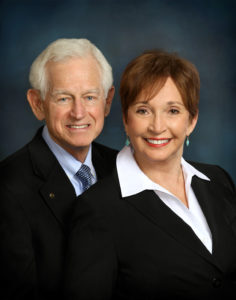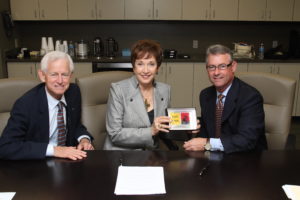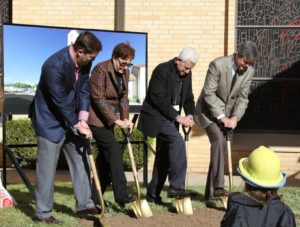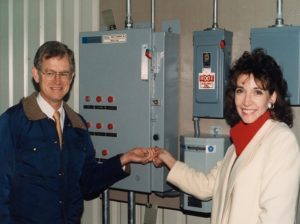The phrase, “She Said Yes!” has become a societal cue to celebrate an engagement. When it comes to Paula and Jim Henry, there’s Paula’s first “Yes!” that led to a wedding in 1964. And then there’s Paula Henry’s second big “Yes,” the “Yes” of 1969 that would mark the beginning of a 50-year-old story that is still being written.
A Ball of Fire and an “Aha!” Moment
Throughout the last five decades, oil and gas enthusiasts have watched Jim Henry grow an independent company into a mainstay of Midland. Celebratory articles have labeled Henry an icon of the West Texas oilfield and one of the founding fathers of the Wolfberry. The history of Henry Petroleum, now Henry Resources LLC, is indeed characterized by sharp business acumen and a keen eye for technology. But the roots were planted in partnership, first between a husband and wife.
Paula and Jim had been married for five years when Jim began considering whether or not to go out on his own.
“I knew that I needed not only Paula’s consent, but her wisdom as well,” Henry shared. Paula’s childhood had included some economic hardships, which the family worked through.
“Paula had good insight on what might be the downside consequences of pursuing such a risky venture, compared to the security [if there be such a thing in the oil industry!] of working for an established company,” Henry recalled.
Before the pair married, Paula had worked for Phillips Petroleum for three years.
“She was not only knowledgeable about the work we would be doing, but also well aware of the demands of the industry on our time,” Henry said. “Perhaps not many wives are risk-takers, but when I asked Paula for her advice, with no hesitation she said, ‘Yes, let’s do it!’ Needless to say, that was the most important ‘Yes, let’s do it!’ in the history of our company.”
The next major milestone of the fledgling company would be some two years later in 1971. Henry Petroleum was drilling its fourth well, the Parham #1 in Martin County. Henry received a call about 6 a.m. one morning from the company’s contract drilling engineer.
“It was the call that no oilman ever wants to get,” Henry remembered. “Our well, which was only about halfway to total depth, had taken a kick and was blowing out.”
Henry jumped into the car and picked up his business partner, Bob Landenberger, and the two “hauled for the rig.”
“It was an extremely foggy morning and we didn’t have much visibility, but we could sure hear the well from a long way off,” Henry detailed. “I will never forget that deafening roar and the pounding of my heart in my throat as we drove on!”
Henry and Landenberger made the last turn onto the caliche entrance to the location and saw what Henry describes as a surreal scene: a spectacular ball of fire suspended way above their heads, roiling and thundering in the thick, foggy sky.
“It looked and sounded like a giant’s blowtorch being fed by a torrent of fuel, and it seemed to me at that moment that nothing could keep the well from burning on forever.
“By God’s grace alone we were later able to gain control of the well and even to produce it successfully.”
The well had blown out in the Grayburg formation at a depth of 3,930 feet, which was not known to be productive in the vicinity at that time. This well led to the discovery of a new Grayburg pool, which Henry and Landenberger aptly named the Phoenix Grayburg Field.
And Their Biggest Breakthrough…
A third defining moment for Jim Henry was one that put the company on the proverbial map. In the summer of 2003, Henry Petroleum drilled and completed the first two wells on the company’s large new acreage play in western Upton County.
“We planned these wells to test a new concept: multistage fracking the Wolfcamp formation using the new George P. Mitchell frac technique,” Henry explained.
These wells were located about 18 miles apart and were named the Beverly #1, after one of the Henrys’ daughters, and the Caitlin #2801, after the granddaughter of one of the company’s managers. Both wells turned out to be very good producers.
“The results suggested to us that all of the acreage in between the wells was probably very productive also,” Henry recounted. “And this conclusion led immediately to our ‘Aha! moment,’ when we realized that not just western Upton County, but the entire Midland Basin might be profitable in this new play. And we were right—we had a mega-discovery!”
This play became known as the Wolfberry, which is now being developed horizontally and has spread across both the Midland and Delaware basins and is estimated to have more than 60 billion barrels and 300 trillion feet of gas recoverable—probably the largest discovery that has ever been made in the Permian Basin.
Henry Petroleum – Henry Resources
In 2008, the Midland-based public company Concho Resources acquired Henry Petroleum and affiliates for about $584 million. Henry regrouped as Henry Resources; he renewed Henry Resources once again in 2010 after selling assets to Linn Energy.
“Henry Resources is very busy today and is carrying on the rich tradition of creating value in the Permian Basin,” Henry shared. Between 2001 and 2019, Henry’s companies drilled and completed more than 1,300 vertical wells.
“However, across the past five years we have shifted our focus away from vertical development to horizontal drilling,” Henry said. “Since 2014 we have drilled approximately 80 horizontal wells. In fact, we have one drilling rig and two frac fleets running today.
“Our normal pace across the past few years has been running one to two horizontal rigs,” he continued. The company operates about 20,000 acres today in both the Midland and Delaware basins.
“Our current net rate is at an all-time high, and we can boast of the second-highest reserves booked in company history [second only to immediately prior to the sale we had to Concho in 2008],” Henry stated. “We are focused on low-geologic-risk projects where we can take advantage of our skills in horizontal drilling and completion.”
The Henry Foundation
In the early going, Paula and Jim Henry noticed that many of the companies that do business in Midland, especially some that are locally owned, not only enjoy the city’s amenities and pay their share of the taxes, but also give back to the community from their money and time.
“Through their giving back, these companies show their appreciation for what the city has given them,” Henry observed. “That’s also what Paula and I want to do, and so we have supported local schools, the fire and police departments, and various municipal and civil projects. We also want to help individuals who live in Midland, in particular people in need.”
The Henry family, personally and through The Henry Foundation, has given quite meaningfully during the past 10 years, with most of it going back into Midland.
“We strive to be a Christian company, and charity and benevolence to the people around us are among our chief priorities,” he continued, “so we created The Henry Foundation.”
The vision, core values, and objectives of the foundation include uniquely worded statements that paint a clear picture of the Henrys’ mindset when it comes to patronage:
Share Christian charity with excellence, i.e., to “live it,” focusing on problem solving and self-help for others.
Teach family giving for the second generation and beyond.
Improve community life, i.e., to be visionary and inspire quality, to think “outside the box,” and promote opportunities for all people in communities
(primarily Midland)…
To invite other foundations and community groups to join in thoughtful giving that addresses root causes and “builds fences” rather than applying “band-aid” fixes for the community.
 In the fabric of these points can be seen the priority that Henry places on training and prevention as opposed to curing and repairing once damage has already occurred. Or, as he pithily puts it, “I would rather pay for fences at the top of a cliff than for ambulances at the bottom.”
In the fabric of these points can be seen the priority that Henry places on training and prevention as opposed to curing and repairing once damage has already occurred. Or, as he pithily puts it, “I would rather pay for fences at the top of a cliff than for ambulances at the bottom.”
Steven H. Pruett, president and CEO of Elevation Resources LLC, Permian Basin, sits on the Henry Foundation Board of Directors.
“Jim Henry is a mentor and role model of mine dating back to the mid-’90s when I first met him due to the way he leads his company, loves his family, and contributes to our community,” Pruett remarked.
Celebration Week
To commemorate the company’s 50-year milestone, Paula and Jim Henry have planned a weeklong celebration from Oct. 28 through Nov. 1 to include a family fun night for current employees and their families; a citywide luncheon reception with past employees, vendors, and industry peers; and a celebratory formal dinner.
“I am beyond blessed to have the privilege and honor to work for Paula and Jim Henry,” shared DiAnn Barker, who has been Jim Henry’s assistant for nine years. “They are like family, and it brings me great pleasure to assist them in all their endeavors. Their pioneering and philanthropic spirit has influenced me and others in the company to work for the common good.”
“Working for Paula and Jim Henry is an honor and a privilege. The Henrys not only believe in their employees, but heavily invest in them as well,” offered Danny Campbell, EVP, CDO and co-manager, Henry Resources. “Jim has always encouraged us not to be afraid of making a mistake because new ideas and technology come with a learning curve. Jim has never been one to bet against technology, but has utilized it in the Wolfberry with slick water fracs and horizontal drilling. He owned one of the first electric cars in Midland.
“He believes in doing what you do well and following Christian principles throughout the operations of the company,” Campbell continued. “The Henrys have also invested heavily in their community, which has made Midland a better place for all of us to live. We join them in celebrating 50 years of success and look forward to a bright future.”
PBPA Benefits from Henry’s Visionary Mindset
When Ben Shepperd moved to Midland in 2006 to run the Permian Basin Petroleum Association (PBPA), one of the first people he met was Jim Henry.
At that time, the PBPA officed in the old Wilco Building, and Henry used a barbershop down the hall from the PBPA, recalled Shepperd, now PBPA president.
“Once a month after his haircut Jim would come by and visit,” Shepperd continued. “We would usually visit for an hour or so. I thought that was incredible, that a man of his stature and reputation, not to mention a very busy man running his companies, would want to spend that much time with me.”
As a former PBPA chairman, Henry held the PBPA in very high regard as the voice of the Permian Basin oil and gas industry, Shepperd shared.
“Jim introduced me to countless people in the area, and it really helped to rebuild the interest in the PBPA,” he continued. “Jim would talk about his vision for the PBPA and how important it was that we had the staff and resources to work throughout the Permian Basin to fully understand the issues we were facing.”
The PBPA leadership selected Jim Henry as its 2006 Top Hand Award Recipient.
When then-PBPA President Kirk Edwards and Shepperd spoke with Henry about the award, Henry agreed to accept the honor under one condition: raise the price of tables to be sold.
“Mind you, back then our top table was $700, and people could attend for $50 per person,” recalled Edwards, president and CEO of Latigo Petroleum, LLC. “Ben and I kind of gulped and asked him what levels he would like. Jim said top level $10,000, then $5,000, and then $2,500 for the lowest level.
“Before we could try and rebut him on those levels being way too high, Jim immediately said, ‘I will take three of the top-level tables right now.’
“Needless to say, Jim transformed what was a nice get-together each year for the PBPA to our most important fundraiser of the organization, and it has only continued to get better and more prestigious since that time,” Edwards summarized.
Henry, known for his “next-steps vision,” was also one of the primary catalysts for the PBPA’s expansion into Austin.
Henry believed that the PBPA needed to have a presence in Austin and Santa Fe, where the legislators and regulators meet, in order to truly be effective industry advocates, Shepperd stated.
“Jim insisted that PBPA open an Austin office at a time when our budget was not adequate to cover the necessary expenditures,” Shepperd continued. “Not to be deterred, Jim provided the seed capital to provide for the first three years of operations. Today, we have a very robust presence in Austin, thanks to Jim, and we also have an office in Santa Fe, N.M.”
“Of course, looking back that is probably one of the key things that has propelled the PBPA into such a distinguished and powerful force to be reckoned with in Austin,” Edwards offered. “This is just another example of how he has contributed so much to the PBPA and changed us for not just today, but for decades to come.”
______________________________________________
By Julie Anderson









